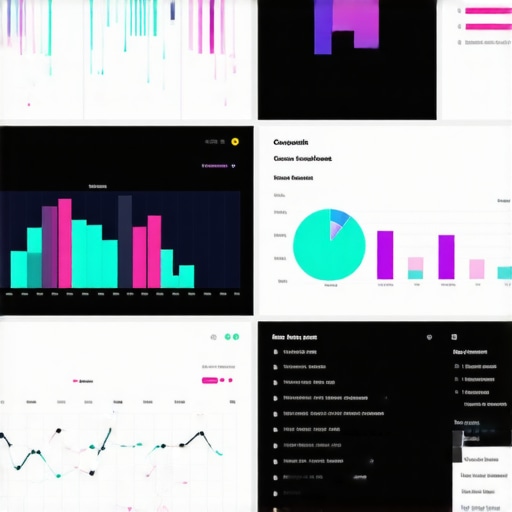Unlocking the Power of CTR Signals for Accelerated Local SEO Success in 2024
In the highly competitive landscape of local search, leveraging Fast GMB SEO & CTR signals has become a strategic imperative for businesses aiming to dominate local rankings swiftly. As digital algorithms evolve, understanding the nuanced interplay between click-through rate (CTR) optimization and local SEO tactics enables marketers to achieve rapid visibility gains. This article explores the sophisticated mechanisms behind CTR signals and their pivotal role in boosting Google My Business (GMB) rankings in 2024.
Deciphering the Complex Relationship Between CTR Signals and Local Rankings
CTR signals act as behavioral metrics that search engines interpret as indicators of relevance and user satisfaction. When a user clicks on a GMB listing, it signals to Google that the business aligns with user intent, thereby positively impacting local ranking algorithms. Advanced practitioners utilize effective CTR strategies such as compelling snippets, localized keywords, and strategic positioning to enhance click rates and accelerate ranking progression.
How to Harness CTR Signals for Rapid Local SEO Growth
Implementing a multi-layered approach involves optimizing GMB profiles with targeted keywords, engaging content, and strategic review management. Additionally, integrating semantic SEO elements like Latent Semantic Indexing (LSI) keywords enriches contextual relevance. Using structured data markup further enhances search snippets, enticing more clicks. For instance, adding Q&A sections fosters engagement and increases CTR, providing additional signals to Google about the listing’s authority and relevance.
What Are the Challenges and Ethical Considerations of CTR Manipulation?
Is it possible to ethically manipulate CTR signals without risking penalties?
While it’s tempting to employ aggressive tactics, ethical SEO practices advocate for genuine engagement and value-driven strategies. Artificial CTR manipulation can lead to penalties or ranking fluctuations if detected. Instead, focusing on authentic user experience enhancements and locality-specific content ensures sustainable growth. The balance lies in optimizing visibility while adhering to search engine guidelines, maintaining trustworthiness and long-term authority.
In conclusion, mastering the sophisticated art of CTR signals and their integration into GMB SEO strategies in 2024 requires a nuanced understanding of search behavior, algorithm updates, and ethical considerations. Regularly analyzing performance metrics and refining tactics based on evolving data will enable local businesses to achieve rapid rankings and sustain competitive advantage.
For further insights, explore our comprehensive guide to CTR optimization techniques or contribute your own expert strategies to foster community knowledge sharing.
Are Your CTR Optimization Techniques Keeping Up with Evolving Search Algorithms?
As search engines become increasingly sophisticated, relying solely on traditional CTR tactics may not suffice for maintaining or improving local rankings. Modern algorithms now incorporate a multitude of behavioral signals, including dwell time, bounce rate, and user engagement metrics, alongside CTR. Therefore, integrating advanced strategies that influence these signals holistically is essential for staying ahead in local SEO. To deepen your understanding, explore comprehensive CTR signal tactics tailored for 2024.
How can businesses ethically leverage emerging behavioral signals to enhance local rankings without risking algorithmic penalties?
Ethical manipulation of behavioral signals involves creating genuinely engaging content, personalized user experiences, and local relevance that naturally encourages interaction. Techniques such as optimizing GMB Q&A sections, utilizing localized multimedia, and fostering authentic reviews contribute to a more engaged audience. Remember, search engines prioritize user trust and authenticity over manipulative tactics. According to Moz’s latest Whiteboard Friday, aligning SEO efforts with user-centric practices ensures sustainable growth and positive algorithmic signals (Moz, 2023).
Interested in refining your local SEO approach? Consider implementing structured data markup to highlight your business’s unique attributes or leveraging local event participation to boost relevance. For more innovative ideas, visit our detailed CTR enhancement strategies.

Mastering the Nuances of CTR Signals and Behavioral Metrics for Sustainable Local SEO Success
As digital landscapes evolve, the importance of sophisticated CTR signal strategies becomes increasingly apparent. Beyond merely optimizing snippets and meta descriptions, advanced practitioners incorporate data-driven insights into user behavior analytics, such as dwell time, bounce rate, and engagement metrics, to refine their local SEO tactics. A comprehensive understanding of these interconnected signals enables businesses to craft highly targeted campaigns that resonate with local audiences and align with evolving search engine algorithms.
Decoding the Synergy Between CTR, User Engagement, and Local Relevance
The true power of CTR signals lies in their ability to serve as a proxy for user satisfaction and content relevance. When a search result garners clicks, it indicates that the listing effectively addresses user intent. However, this is just one piece of the puzzle. Integrating behavioral data like time spent on site, interaction rates with GMB features such as Q&A or booking buttons, and social sharing patterns creates a holistic view of user engagement. This multi-layered approach informs more nuanced SEO strategies that prioritize local relevance, personalized content, and technical excellence.
How does Google interpret combined CTR and behavioral signals to rank local businesses?
Google’s algorithms utilize machine learning models that weigh various behavioral signals alongside traditional SEO factors. According to a 2023 report by Search Engine Journal, signals such as increased dwell time, low bounce rates, and active engagement with GMB features contribute significantly to local ranking improvements. These signals help Google assess not just the likelihood of a click, but the quality of user interaction post-click, which ultimately influences ranking adjustments in competitive local searches.
To harness these insights effectively, businesses should employ tools like Google Analytics and specialized local SEO platforms that track these nuanced metrics in real-time. Adjusting content strategies based on this data—such as enhancing multimedia content for mobile users or optimizing for voice search—can create a virtuous cycle of increased engagement and higher rankings.

Innovative Techniques for Ethical CTR and Behavioral Signal Optimization
While the temptation to manipulate signals artificially persists, ethical optimization hinges on delivering genuine value. Techniques such as localized storytelling, community-focused content, and personalized user experiences naturally encourage engagement without risking penalties. Furthermore, leveraging structured data markup to highlight unique selling propositions, service offerings, and local events amplifies visibility and click appeal.
Additionally, fostering authentic reviews and actively engaging with customer Q&A sections cultivates trust and increases user interaction metrics. These efforts, rooted in transparency and value, align with Google’s guidelines and support sustainable growth.
Future-Proofing Your Local SEO Strategy in an Algorithm-Driven World
As search engine algorithms become more context-aware, the integration of behavioral signals into your local SEO strategy must be an ongoing process. Staying ahead requires continuous analysis of emerging data points, adapting content to new formats like video and voice, and maintaining a strong local community presence. The use of AI-powered tools for predictive analytics can help anticipate shifts in user behavior, enabling proactive adjustments.
In conclusion, mastering the interplay between CTR signals, behavioral metrics, and local relevance is paramount for achieving rapid and sustainable rankings in 2024. By prioritizing authentic engagement and leveraging advanced data insights, businesses can navigate the complex landscape of local SEO with confidence. For those eager to deepen their expertise, exploring specialized resources and staying connected with industry thought leaders remains essential.
Harnessing Deep Behavioral Analytics for Cutting-Edge Local SEO Dominance
In the rapidly evolving domain of local search, merely optimizing for traditional CTR metrics is no longer sufficient. Forward-thinking marketers delve into complex behavioral analytics—such as scroll depth, micro-interactions, and multi-device engagement—to craft hyper-targeted campaigns that resonate with local audiences. Leveraging tools like heatmaps and session recordings enables a granular understanding of user journeys, allowing businesses to refine their local SEO strategies with surgical precision.
Integrating Contextual User Signals with Semantic SEO for Elevated Rankings
The true sophistication in local SEO emerges when behavioral signals are contextualized within semantic frameworks. By incorporating Latent Semantic Indexing (LSI) keywords and structured data, businesses can align user intent more accurately with their content. This synergy enhances the relevance signals sent to Google, elevating local rankings. For instance, embedding schema markup for local business attributes ensures that behavioral engagement—such as clicking on specific service categories—translates into tangible ranking advantages.
What are the latest machine learning techniques used by search engines to interpret complex behavioral data?
Recent advancements involve deep neural networks and graph-based models that analyze multi-dimensional behavioral datasets, including dwell time, interaction sequences, and social sharing patterns. According to a 2023 Google research paper, these models enable the engine to predict user satisfaction with remarkable accuracy, influencing rankings beyond traditional signals. Understanding these AI-driven interpretative mechanisms empowers local SEO specialists to align their tactics with the most sophisticated ranking criteria. For authoritative insights, consult Google’s AI research publications in the Google AI Blog.
To stay at the forefront of this complex landscape, marketers should invest in advanced analytics platforms and foster a culture of data-driven experimentation. This approach not only enhances immediate visibility but also builds resilient, future-proof SEO frameworks that adapt seamlessly to algorithmic shifts.
< >
>
Beyond Clicks: Cultivating Authentic Engagement to Sustain Long-Term Local Rankings
While optimizing for behavioral signals provides a competitive edge, the foundation remains authentic engagement. Strategies such as community-driven content, personalized messaging, and interactive multimedia foster genuine relationships that naturally boost behavioral metrics. For example, hosting local webinars or community events and promoting these via GMB can generate organic interest and real user interactions that search engines interpret as high-quality signals.
Moreover, integrating emerging technologies like augmented reality (AR) for local showcase experiences can elevate user engagement to new heights, creating memorable interactions that translate into sustained rankings. As Moz’s latest Whiteboard Friday emphasizes, authenticity and user-centricity are paramount for long-term SEO success.
Future Trends: Harnessing AI and Predictive Analytics for Proactive Local SEO Optimization
The future of local SEO hinges on proactive adaptation. AI-powered predictive analytics can forecast shifts in user behavior, enabling businesses to tailor their strategies dynamically. For instance, analyzing seasonal engagement patterns or emerging local trends allows for timely content updates and feature enhancements. Incorporating voice search optimization and mobile-first approaches further aligns with evolving user preferences, ensuring that behavioral signals remain robust and relevant.
In conclusion, mastering the intricate interplay between advanced behavioral metrics and semantic relevance is essential for securing dominant local search positions in 2024. Embrace the power of comprehensive data analysis, innovative engagement techniques, and future-ready technologies to elevate your local SEO game. For expert guidance and tailored strategies, explore leading industry resources and participate in ongoing knowledge sharing within the SEO community.
Expert Insights & Advanced Considerations
1. Behavioral Signal Synergy Elevates Rankings
Integrating behavioral metrics such as dwell time, bounce rate, and engagement with CTR signals creates a comprehensive ranking framework that search engines interpret as high relevance, especially in competitive local markets.
2. Semantic SEO and Structured Data as Amplifiers
Embedding Latent Semantic Indexing (LSI) keywords alongside structured data markup enhances contextual relevance, ensuring that user interactions translate into meaningful ranking boosts without violating ethical standards.
3. Machine Learning Models Dictate Future Optimization
Understanding how search engines utilize deep neural networks to analyze complex behavioral datasets allows SEOs to craft strategies aligned with AI-driven ranking criteria, fostering sustainable growth.
4. Authentic Engagement Over Manipulation
Prioritizing genuine user experiences—such as community involvement, personalized content, and authentic reviews—builds trust and sustains long-term rankings, avoiding penalties associated with artificial CTR manipulation.
5. Continuous Data-Driven Adaptation
Employing advanced analytics tools for real-time behavioral insights enables proactive strategy adjustments, keeping local SEO efforts aligned with evolving search engine algorithms and user preferences.
Curated Expert Resources
- Google’s AI Research Publications: Offers insights into machine learning techniques influencing search rankings, essential for understanding AI-driven behavioral analysis.
- Moz’s Whiteboard Friday Series: Provides authoritative discussions on ethical SEO practices and behavioral signals, emphasizing sustainable strategies.
- Search Engine Journal’s Deep Dive Articles: Features advanced case studies and technical guides on leveraging behavioral metrics for local SEO success.
- Schema.org Documentation: Guides on implementing structured data markup to maximize relevance signals and CTR effectiveness.
Final Expert Perspective
Mastering the nuances of CTR signals and behavioral metrics in local SEO 2024 demands a sophisticated, ethical approach that synergizes technical optimization with authentic user engagement. By focusing on deep data insights, semantic relevance, and AI-aligned tactics, professionals can unlock rapid and sustainable local rankings. For those committed to elevating their expertise, engaging with authoritative resources and contributing to industry discussions will ensure enduring success in this dynamic landscape. Dive deeper into these strategies and share your insights to shape the future of local SEO excellence.


This post really highlights the importance of integrating behavioral analytics with traditional SEO approaches for local rankings. I’ve personally seen that optimizing GMB profiles with localized content and actively engaging with reviews and Q&A not only boosts CTR but also builds trust within the community. I find the emphasis on ethical practices refreshing, especially in today’s climate where quick wins can sometimes lead to penalties. One challenge I often face is balancing the need for immediate visibility with sustainable growth strategies. Have others experimented with using AR or multimedia content to enhance local engagement? I’d love to hear how these strategies have worked in different industries or regions. Overall, leveraging deep analytics and smart structured data seems to be the way forward to stay ahead in 2024’s evolving local SEO landscape.
The post’s focus on CTR signals as a key driver for rapid local SEO success in 2024 really resonated with me. From my experience managing local campaigns, I’ve found that combining optimized Google My Business profiles with strategic use of structured data can significantly enhance visibility and user engagement. The idea of leveraging behavioral signals like dwell time and social sharing aligns with my approach of creating locally relevant content that genuinely interests the community. One challenge I encounter, however, is balancing quick tactical wins with building authentic local trust, especially in competitive markets where some shortcuts might seem tempting but risky. Have others successfully integrated emerging AI tools for predictive analytics to anticipate shifts in user behavior? I believe that continuous evolution and ethical practices will be crucial to sustaining local rankings as algorithms become more sophisticated. Would love to hear from others on how they’re adapting their strategies in this area.
This article offers valuable insights into how CTR signals and behavioral data are becoming central to local SEO strategies in 2024. I’ve noticed that businesses investing in multimedia content like videos and local storytelling tend to see a natural uptick in engagement and CTR, which aligns with the post’s emphasis on authentic value. One challenge I’ve faced is measuring the long-term impact of these behavioral signals amidst changing algorithms. Has anyone experimented with integrating voice search optimization or mobile-first content to further boost CTR and engagement? I believe that combining technical improvements with genuine local relevance is key to sustainable growth. Also, leveraging AI tools for predictive analytics sounds promising, but ensuring the data remains ethical and transparent is essential. Would love to hear experiences from others who have adopted such AI-driven approaches for behavioral insights—what tools or strategies have been most effective? Overall, it feels like a balanced mix of technical SEO, authentic content, and smart data analytics is shaping the future of local rankings.